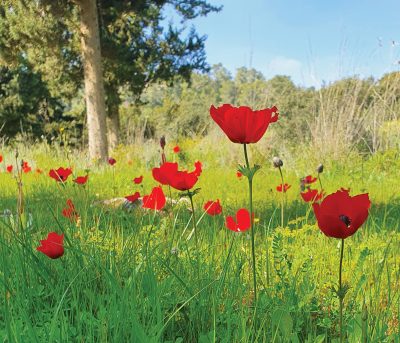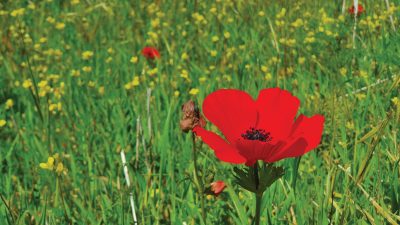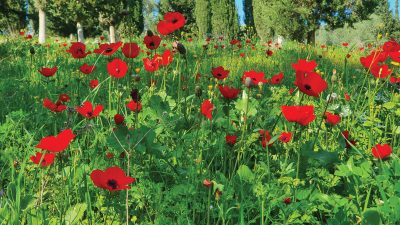
by: Kathy DeGagne, BFP Staff Writer
 After seeing photos of the lush, green Galilee, an astonished friend told me that she thought Israel was all desert. Israel is not exactly all desert, but desert does make up almost 60% of the nation’s land mass. I expect she envisioned camel caravans making their way across endless dunes of sand, but, in fact, the desert of Israel is comprised primarily of rocky outcrops and mountains, deep craters and dry riverbeds.
After seeing photos of the lush, green Galilee, an astonished friend told me that she thought Israel was all desert. Israel is not exactly all desert, but desert does make up almost 60% of the nation’s land mass. I expect she envisioned camel caravans making their way across endless dunes of sand, but, in fact, the desert of Israel is comprised primarily of rocky outcrops and mountains, deep craters and dry riverbeds.
One spring weekend, a group of us decided to travel into the desert. We wanted to see the stars, because the desert night sky is spectacular—but the stark beauty of the desert landscape can be just as compelling.
Traveling south from the heights of Jerusalem, we immediately descended into the Judean Desert to the lowest point on the face of the earth: the Dead Sea. At approximately 430 meters (1,410 feet) below sea level, the Dead Sea is a remarkable feature of the Israeli landscape and one of the most unique bodies of water in the world. It has the highest mineral content of any sea on earth, making it extremely buoyant and a natural health spa. Fish and other marine life cannot survive the water’s salinity, but the prophet Ezekiel said that someday, a fresh stream of water would flow from Jerusalem down the Jordan Valley and into the Dead Sea. Ezekiel went on to say that there would be a day when fishermen would stand along the shores of the Dead Sea near Ein Gedi and spread their nets there because fish would once again thrive in its fresh water (47:7–10).
Over 3,000 years ago, a future King David found refuge from King Saul among the rocks of Ein Gedi. It is a beautiful oasis of clear, flowing water—living water—in the midst of the wilderness. Several waterfalls flow down from the rocky heights, called the Upper and Lower David Falls. We climbed the high cliff above the falls to the freshwater spring and turned around on a wide, rocky ledge near the top to drink in the long vista towards the Dead Sea.
 From the edge of the Judean Wilderness, we entered the Negev Desert. The word negev (or negeb) means “dry” in Hebrew. And dry it is! There is zero rainfall between June and October, and temperatures have soared to a record 53°C (127°F) in some years. Summer temperatures normally average about 32°C (90°F).
From the edge of the Judean Wilderness, we entered the Negev Desert. The word negev (or negeb) means “dry” in Hebrew. And dry it is! There is zero rainfall between June and October, and temperatures have soared to a record 53°C (127°F) in some years. Summer temperatures normally average about 32°C (90°F).
In spite of the dry conditions, the semiarid northern Negev in springtime is blanketed with fields of yellow daisies and splashed with scarlet, white and purple anemones. The Hebrew name for anemone is Kalanit, which refers to the beauty of a bride, kala. Jesus (Yeshua) may have been referring to anemones when He said, “See how the flowers of the field grow. They do not labor or spin. Yet I tell you that not even Solomon in all his splendor was dressed like one of these” (Matt. 6:28b–29 NIV).
Along with the anemones, colorful clusters of violet cyclamen blossoms transform the desert wasteland into a Garden of Eden. The cyclamen represents the spirit of the Israeli people: against all odds, they manage to grow and flourish in hard, rocky soil.
We stopped for the night at a Bedouin camel ranch and slept out under a myriad of stars in a black desert sky. Bedouins—nomadic tribes who thrive in the desert—have known this thrill for centuries, but it was an awesome treat for us city folk. It reminded me of God’s covenant with Abraham: “‘Look up at the sky and count the stars—if indeed you can count them.’ Then He said to him, ‘So shall your offspring be’…On that day the Lord made a covenant with Abram…” (Gen. 15:5,18 NIV).
 It was once thought that the desert was unfit for homesteading or agriculture. However, though it is still sparsely populated with only about 10% of Israel’s total population, residents of various kibbutzim and moshavim (cooperative agricultural communities) have reclaimed the desert and turned many acres of wasteland into vast expanses of producing greenhouses, date palm groves and vineyards. Isaiah 27:6 promises that “in days to come…Israel will bud and blossom and fill all the world with fruit” (NIV).
It was once thought that the desert was unfit for homesteading or agriculture. However, though it is still sparsely populated with only about 10% of Israel’s total population, residents of various kibbutzim and moshavim (cooperative agricultural communities) have reclaimed the desert and turned many acres of wasteland into vast expanses of producing greenhouses, date palm groves and vineyards. Isaiah 27:6 promises that “in days to come…Israel will bud and blossom and fill all the world with fruit” (NIV).
Two thousand years ago, ancient winemaking was an important industry in the desert. Once again, grapes are being grown in the Negev. Several years ago, I visited a moshav in the Arava (the eastern part of the Negev and part of the Rift Valley) where they were producing two grape harvests a year. It was a prophetic fulfillment of Amos 9:13–15, which tells us that grapes will one day grow faster than the wine can be made.
Because Israel has had to develop solutions for growing crops in arid, adverse conditions, it is in the forefront of the world’s agricultural innovation—especially in the areas of irrigation and water recycling—and is sharing this technical know-how with the rest of the world, fulfilling its God-given call to be a light to the nations. In fact, drought-plagued Israel is now able to desalinate much of its water from the Mediterranean and exports water to other nations in the region that are on the brink of water scarcity.
David Ben Gurion, Israel’s first prime minister, moved to the Negev with a dream to make the desert bloom. He believed that the Negev would be central to Israel’s growth as a nation. Today, Ben Gurion’s dream is being realized. The desert is flourishing with thriving agricultural communities—blossoming, just as God said it would—a stunningly beautiful place with a fascinating past and a prophetic future.
Photo Credit: Nathan Williams/bridgesforpeace.com
All logos and trademarks in this site are property of their respective owner. All other materials are property of Bridges for Peace. Copyright © 2025.
Website Site Design by J-Town Internet Services Ltd. - Based in Jerusalem and Serving the World.